Developing Individuals, Teams & Organisations (pdf)
VerifiedAdded on 2021/01/02
|20
|5101
|492
AI Summary
Contribute Materials
Your contribution can guide someone’s learning journey. Share your
documents today.
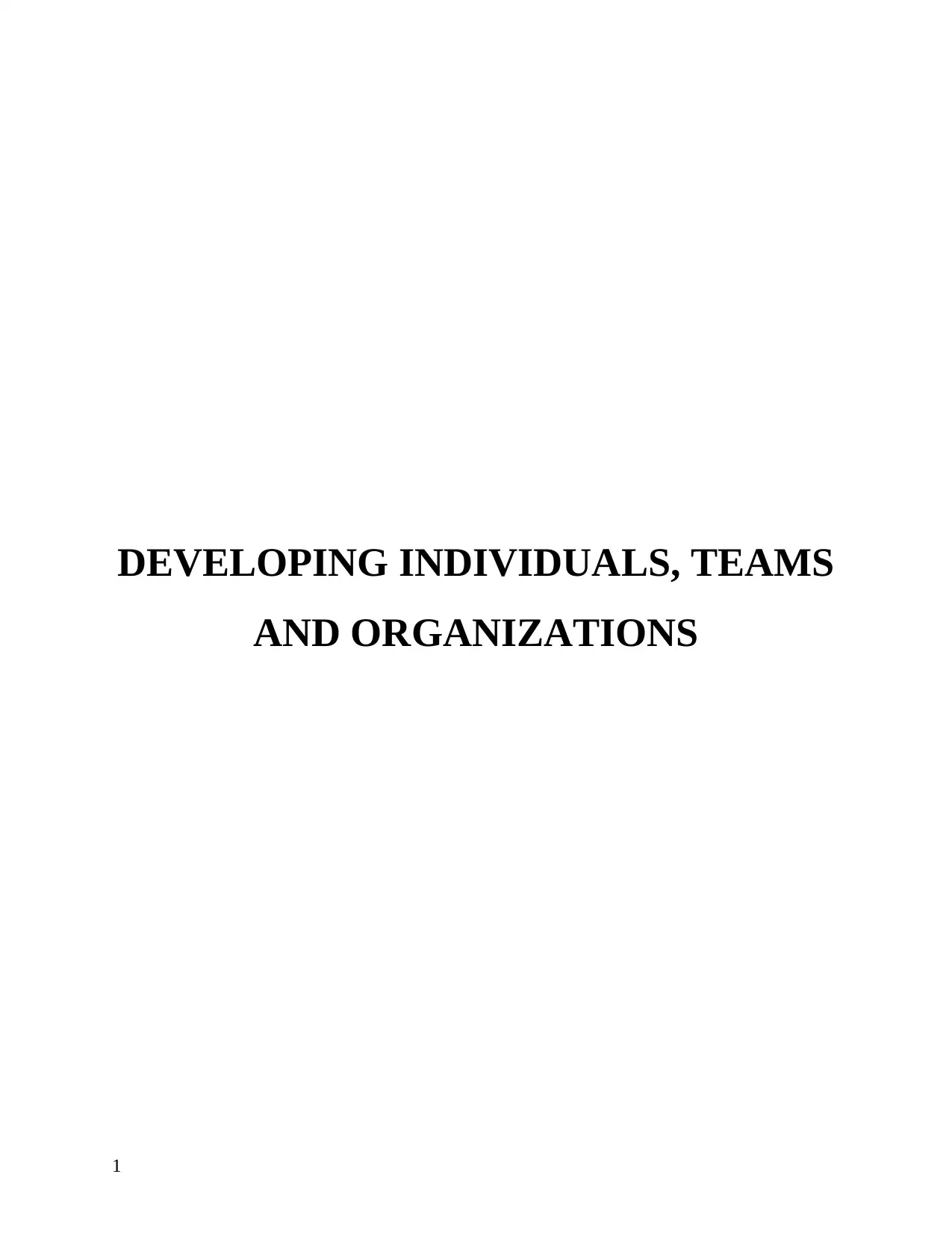
DEVELOPING INDIVIDUALS, TEAMS
AND ORGANIZATIONS
1
AND ORGANIZATIONS
1
Secure Best Marks with AI Grader
Need help grading? Try our AI Grader for instant feedback on your assignments.
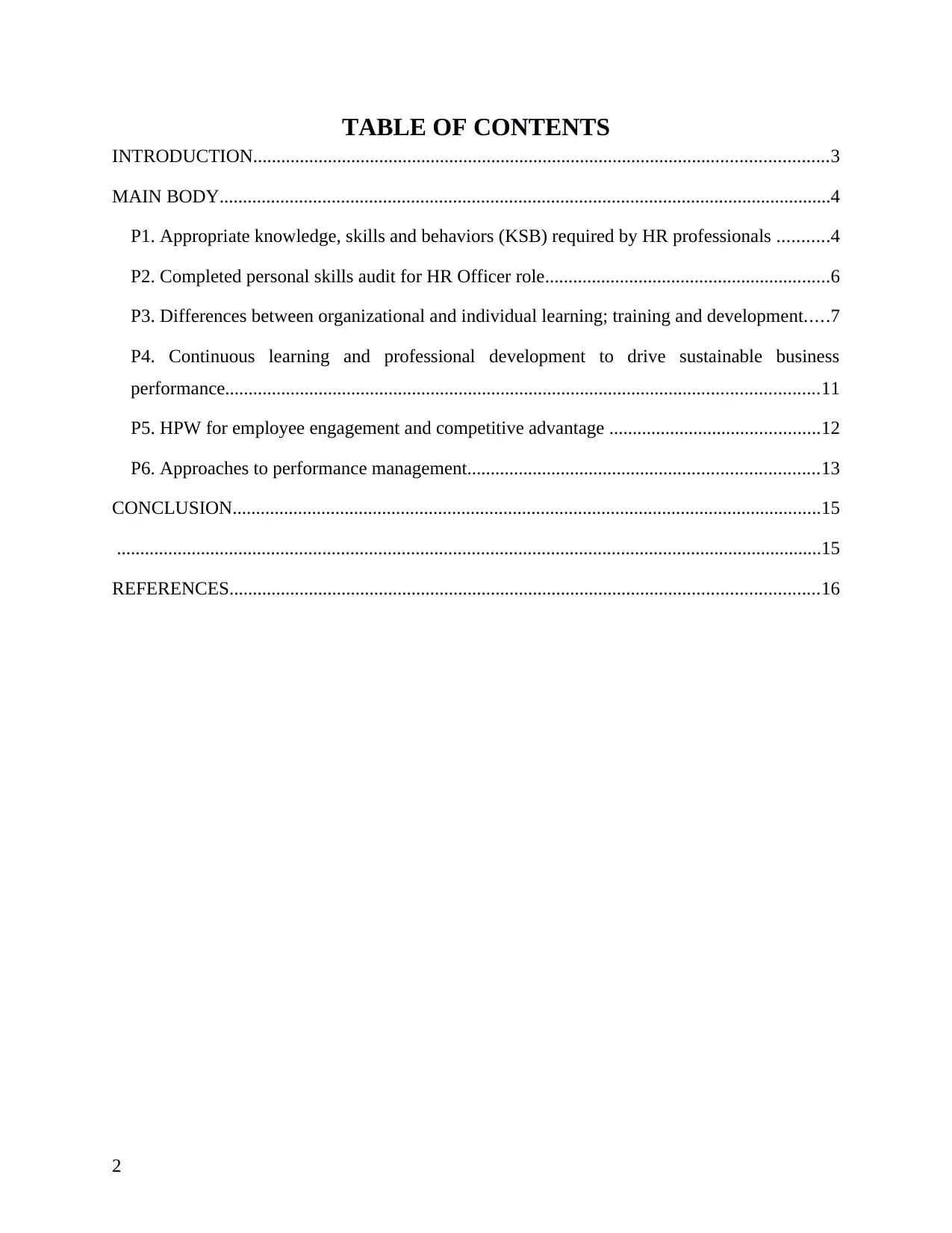
TABLE OF CONTENTS
INTRODUCTION...........................................................................................................................3
MAIN BODY...................................................................................................................................4
P1. Appropriate knowledge, skills and behaviors (KSB) required by HR professionals ...........4
P2. Completed personal skills audit for HR Officer role.............................................................6
P3. Differences between organizational and individual learning; training and development.....7
P4. Continuous learning and professional development to drive sustainable business
performance...............................................................................................................................11
P5. HPW for employee engagement and competitive advantage .............................................12
P6. Approaches to performance management...........................................................................13
CONCLUSION..............................................................................................................................15
.......................................................................................................................................................15
REFERENCES..............................................................................................................................16
2
INTRODUCTION...........................................................................................................................3
MAIN BODY...................................................................................................................................4
P1. Appropriate knowledge, skills and behaviors (KSB) required by HR professionals ...........4
P2. Completed personal skills audit for HR Officer role.............................................................6
P3. Differences between organizational and individual learning; training and development.....7
P4. Continuous learning and professional development to drive sustainable business
performance...............................................................................................................................11
P5. HPW for employee engagement and competitive advantage .............................................12
P6. Approaches to performance management...........................................................................13
CONCLUSION..............................................................................................................................15
.......................................................................................................................................................15
REFERENCES..............................................................................................................................16
2

INTRODUCTION
Developing individuals, teams and organizations is central key-point for the development
and succession by performing the functions in appropriate manner with the ulterior aim of
moving in the forwarding course. It emphasizes on suitable training and development for laying
a platform to have positive effects on the business environment in context to both individual and
organizational levels. Moreover, the continuous professional development is the tool which
enlightens the cyclic learning with respect to the employees’ engagement and gaining insights
for sustainable performance management in context of Sainsbury's business environment(Van
Dooren, Bouckaert and Halligan, 2015). This assignment will focus on understanding the
significance of professional skills, knowledge and behavior of HR professionals. It will also
describe about high performance working cultures for improving profitability and productivity of
Sainsbury's .
Figure 1. Cyclic approachability for developing individuals, teams and organizations
(Source: Unleashing the Potential of Individuals, Teams, and Organizations, 2018)
3
Developing individuals, teams and organizations is central key-point for the development
and succession by performing the functions in appropriate manner with the ulterior aim of
moving in the forwarding course. It emphasizes on suitable training and development for laying
a platform to have positive effects on the business environment in context to both individual and
organizational levels. Moreover, the continuous professional development is the tool which
enlightens the cyclic learning with respect to the employees’ engagement and gaining insights
for sustainable performance management in context of Sainsbury's business environment(Van
Dooren, Bouckaert and Halligan, 2015). This assignment will focus on understanding the
significance of professional skills, knowledge and behavior of HR professionals. It will also
describe about high performance working cultures for improving profitability and productivity of
Sainsbury's .
Figure 1. Cyclic approachability for developing individuals, teams and organizations
(Source: Unleashing the Potential of Individuals, Teams, and Organizations, 2018)
3
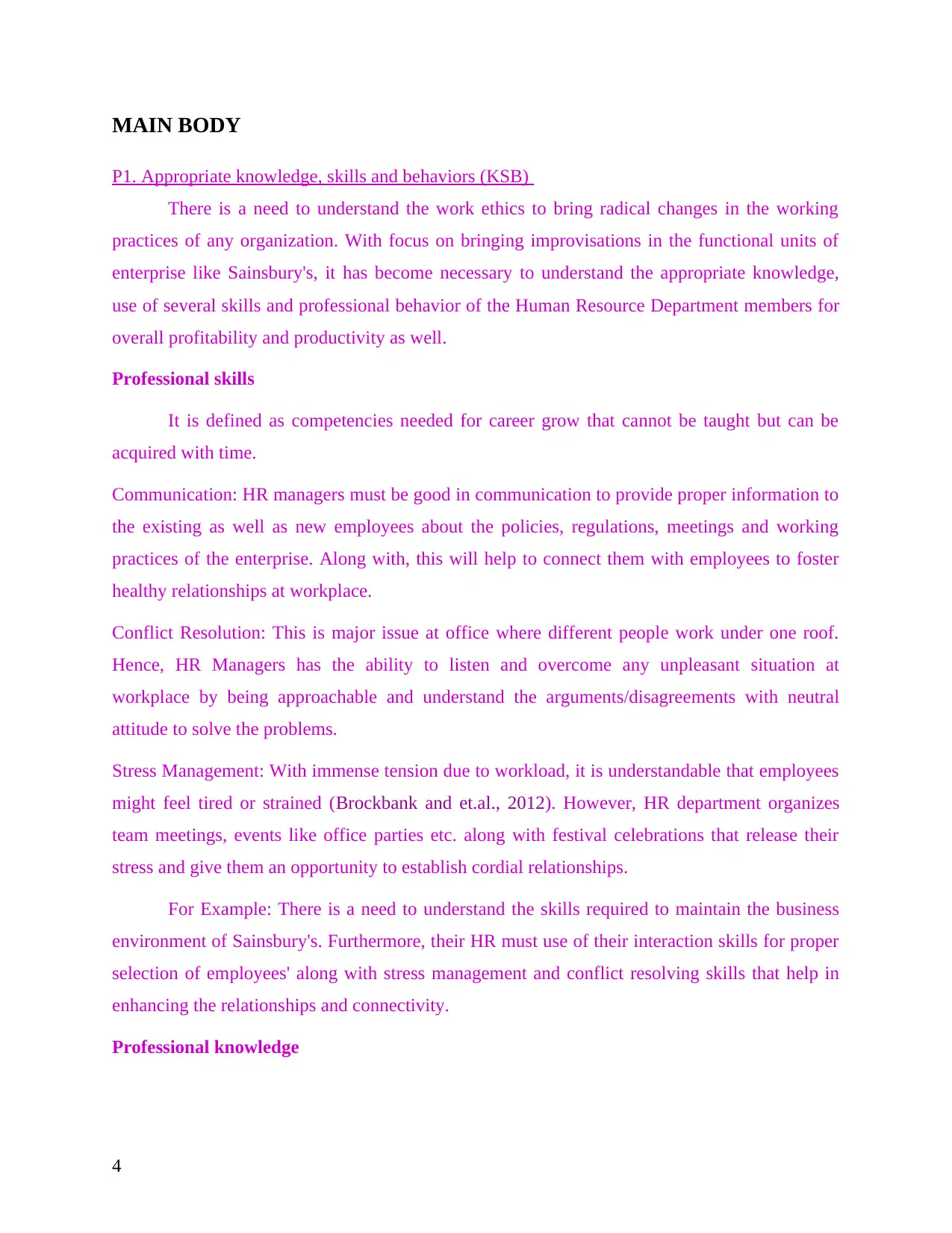
MAIN BODY
P1. Appropriate knowledge, skills and behaviors (KSB)
There is a need to understand the work ethics to bring radical changes in the working
practices of any organization. With focus on bringing improvisations in the functional units of
enterprise like Sainsbury's, it has become necessary to understand the appropriate knowledge,
use of several skills and professional behavior of the Human Resource Department members for
overall profitability and productivity as well.
Professional skills
It is defined as competencies needed for career grow that cannot be taught but can be
acquired with time.
Communication: HR managers must be good in communication to provide proper information to
the existing as well as new employees about the policies, regulations, meetings and working
practices of the enterprise. Along with, this will help to connect them with employees to foster
healthy relationships at workplace.
Conflict Resolution: This is major issue at office where different people work under one roof.
Hence, HR Managers has the ability to listen and overcome any unpleasant situation at
workplace by being approachable and understand the arguments/disagreements with neutral
attitude to solve the problems.
Stress Management: With immense tension due to workload, it is understandable that employees
might feel tired or strained (Brockbank and et.al., 2012). However, HR department organizes
team meetings, events like office parties etc. along with festival celebrations that release their
stress and give them an opportunity to establish cordial relationships.
For Example: There is a need to understand the skills required to maintain the business
environment of Sainsbury's. Furthermore, their HR must use of their interaction skills for proper
selection of employees' along with stress management and conflict resolving skills that help in
enhancing the relationships and connectivity.
Professional knowledge
4
P1. Appropriate knowledge, skills and behaviors (KSB)
There is a need to understand the work ethics to bring radical changes in the working
practices of any organization. With focus on bringing improvisations in the functional units of
enterprise like Sainsbury's, it has become necessary to understand the appropriate knowledge,
use of several skills and professional behavior of the Human Resource Department members for
overall profitability and productivity as well.
Professional skills
It is defined as competencies needed for career grow that cannot be taught but can be
acquired with time.
Communication: HR managers must be good in communication to provide proper information to
the existing as well as new employees about the policies, regulations, meetings and working
practices of the enterprise. Along with, this will help to connect them with employees to foster
healthy relationships at workplace.
Conflict Resolution: This is major issue at office where different people work under one roof.
Hence, HR Managers has the ability to listen and overcome any unpleasant situation at
workplace by being approachable and understand the arguments/disagreements with neutral
attitude to solve the problems.
Stress Management: With immense tension due to workload, it is understandable that employees
might feel tired or strained (Brockbank and et.al., 2012). However, HR department organizes
team meetings, events like office parties etc. along with festival celebrations that release their
stress and give them an opportunity to establish cordial relationships.
For Example: There is a need to understand the skills required to maintain the business
environment of Sainsbury's. Furthermore, their HR must use of their interaction skills for proper
selection of employees' along with stress management and conflict resolving skills that help in
enhancing the relationships and connectivity.
Professional knowledge
4
Secure Best Marks with AI Grader
Need help grading? Try our AI Grader for instant feedback on your assignments.
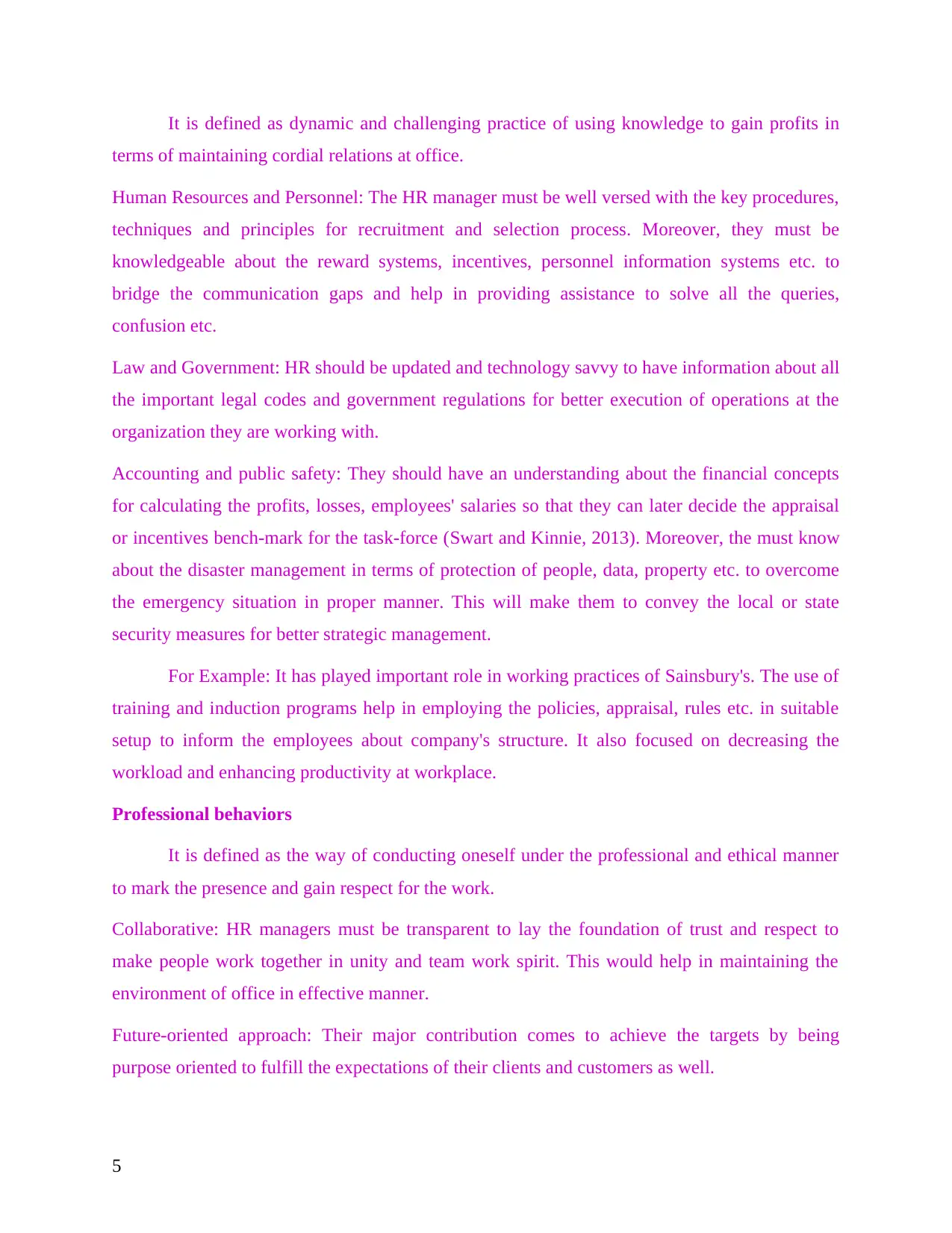
It is defined as dynamic and challenging practice of using knowledge to gain profits in
terms of maintaining cordial relations at office.
Human Resources and Personnel: The HR manager must be well versed with the key procedures,
techniques and principles for recruitment and selection process. Moreover, they must be
knowledgeable about the reward systems, incentives, personnel information systems etc. to
bridge the communication gaps and help in providing assistance to solve all the queries,
confusion etc.
Law and Government: HR should be updated and technology savvy to have information about all
the important legal codes and government regulations for better execution of operations at the
organization they are working with.
Accounting and public safety: They should have an understanding about the financial concepts
for calculating the profits, losses, employees' salaries so that they can later decide the appraisal
or incentives bench-mark for the task-force (Swart and Kinnie, 2013). Moreover, the must know
about the disaster management in terms of protection of people, data, property etc. to overcome
the emergency situation in proper manner. This will make them to convey the local or state
security measures for better strategic management.
For Example: It has played important role in working practices of Sainsbury's. The use of
training and induction programs help in employing the policies, appraisal, rules etc. in suitable
setup to inform the employees about company's structure. It also focused on decreasing the
workload and enhancing productivity at workplace.
Professional behaviors
It is defined as the way of conducting oneself under the professional and ethical manner
to mark the presence and gain respect for the work.
Collaborative: HR managers must be transparent to lay the foundation of trust and respect to
make people work together in unity and team work spirit. This would help in maintaining the
environment of office in effective manner.
Future-oriented approach: Their major contribution comes to achieve the targets by being
purpose oriented to fulfill the expectations of their clients and customers as well.
5
terms of maintaining cordial relations at office.
Human Resources and Personnel: The HR manager must be well versed with the key procedures,
techniques and principles for recruitment and selection process. Moreover, they must be
knowledgeable about the reward systems, incentives, personnel information systems etc. to
bridge the communication gaps and help in providing assistance to solve all the queries,
confusion etc.
Law and Government: HR should be updated and technology savvy to have information about all
the important legal codes and government regulations for better execution of operations at the
organization they are working with.
Accounting and public safety: They should have an understanding about the financial concepts
for calculating the profits, losses, employees' salaries so that they can later decide the appraisal
or incentives bench-mark for the task-force (Swart and Kinnie, 2013). Moreover, the must know
about the disaster management in terms of protection of people, data, property etc. to overcome
the emergency situation in proper manner. This will make them to convey the local or state
security measures for better strategic management.
For Example: It has played important role in working practices of Sainsbury's. The use of
training and induction programs help in employing the policies, appraisal, rules etc. in suitable
setup to inform the employees about company's structure. It also focused on decreasing the
workload and enhancing productivity at workplace.
Professional behaviors
It is defined as the way of conducting oneself under the professional and ethical manner
to mark the presence and gain respect for the work.
Collaborative: HR managers must be transparent to lay the foundation of trust and respect to
make people work together in unity and team work spirit. This would help in maintaining the
environment of office in effective manner.
Future-oriented approach: Their major contribution comes to achieve the targets by being
purpose oriented to fulfill the expectations of their clients and customers as well.
5
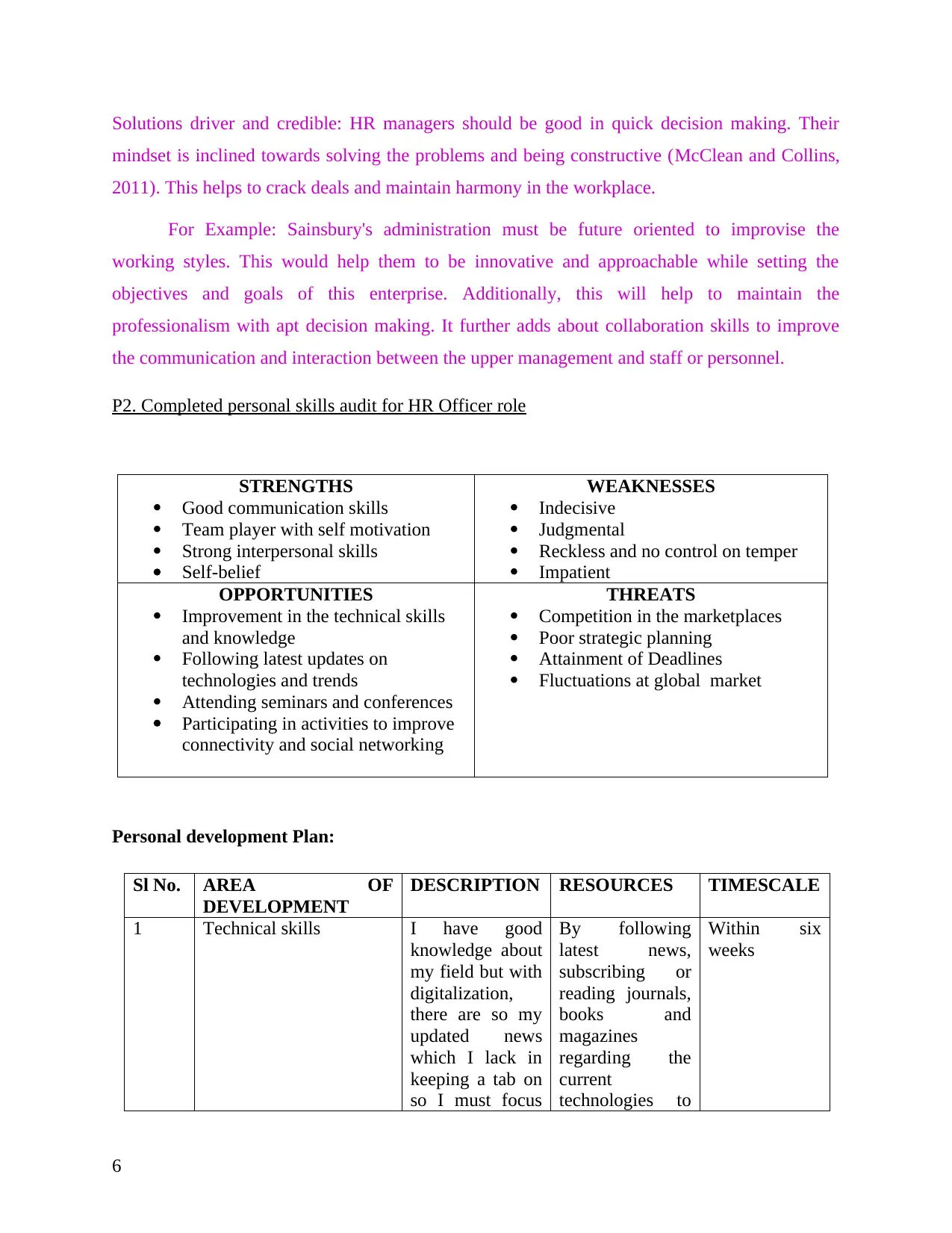
Solutions driver and credible: HR managers should be good in quick decision making. Their
mindset is inclined towards solving the problems and being constructive (McClean and Collins,
2011). This helps to crack deals and maintain harmony in the workplace.
For Example: Sainsbury's administration must be future oriented to improvise the
working styles. This would help them to be innovative and approachable while setting the
objectives and goals of this enterprise. Additionally, this will help to maintain the
professionalism with apt decision making. It further adds about collaboration skills to improve
the communication and interaction between the upper management and staff or personnel.
P2. Completed personal skills audit for HR Officer role
STRENGTHS
Good communication skills
Team player with self motivation
Strong interpersonal skills
Self-belief
WEAKNESSES
Indecisive
Judgmental
Reckless and no control on temper
Impatient
OPPORTUNITIES
Improvement in the technical skills
and knowledge
Following latest updates on
technologies and trends
Attending seminars and conferences
Participating in activities to improve
connectivity and social networking
THREATS
Competition in the marketplaces
Poor strategic planning
Attainment of Deadlines
Fluctuations at global market
Personal development Plan:
Sl No. AREA OF
DEVELOPMENT
DESCRIPTION RESOURCES TIMESCALE
1 Technical skills I have good
knowledge about
my field but with
digitalization,
there are so my
updated news
which I lack in
keeping a tab on
so I must focus
By following
latest news,
subscribing or
reading journals,
books and
magazines
regarding the
current
technologies to
Within six
weeks
6
mindset is inclined towards solving the problems and being constructive (McClean and Collins,
2011). This helps to crack deals and maintain harmony in the workplace.
For Example: Sainsbury's administration must be future oriented to improvise the
working styles. This would help them to be innovative and approachable while setting the
objectives and goals of this enterprise. Additionally, this will help to maintain the
professionalism with apt decision making. It further adds about collaboration skills to improve
the communication and interaction between the upper management and staff or personnel.
P2. Completed personal skills audit for HR Officer role
STRENGTHS
Good communication skills
Team player with self motivation
Strong interpersonal skills
Self-belief
WEAKNESSES
Indecisive
Judgmental
Reckless and no control on temper
Impatient
OPPORTUNITIES
Improvement in the technical skills
and knowledge
Following latest updates on
technologies and trends
Attending seminars and conferences
Participating in activities to improve
connectivity and social networking
THREATS
Competition in the marketplaces
Poor strategic planning
Attainment of Deadlines
Fluctuations at global market
Personal development Plan:
Sl No. AREA OF
DEVELOPMENT
DESCRIPTION RESOURCES TIMESCALE
1 Technical skills I have good
knowledge about
my field but with
digitalization,
there are so my
updated news
which I lack in
keeping a tab on
so I must focus
By following
latest news,
subscribing or
reading journals,
books and
magazines
regarding the
current
technologies to
Within six
weeks
6
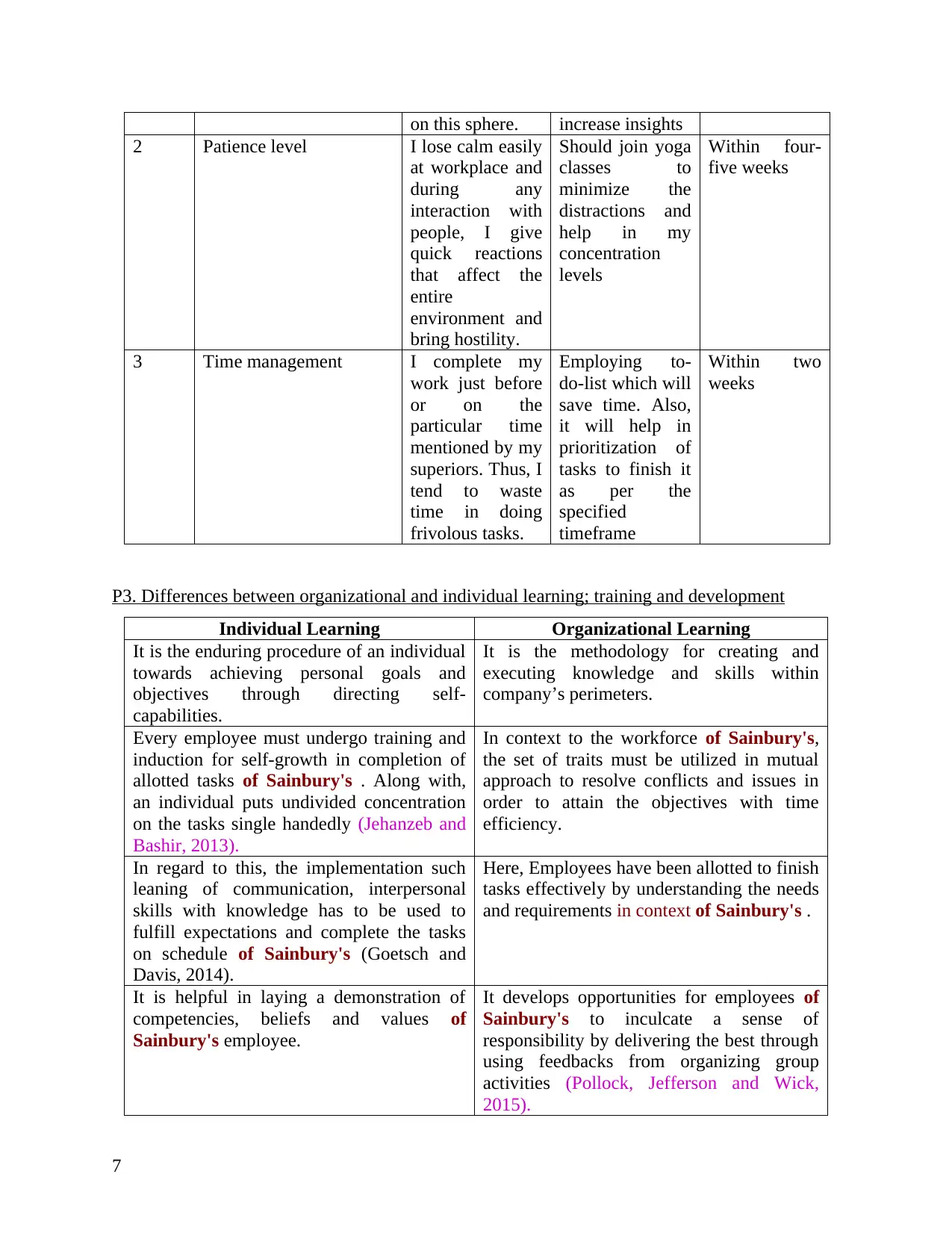
on this sphere. increase insights
2 Patience level I lose calm easily
at workplace and
during any
interaction with
people, I give
quick reactions
that affect the
entire
environment and
bring hostility.
Should join yoga
classes to
minimize the
distractions and
help in my
concentration
levels
Within four-
five weeks
3 Time management I complete my
work just before
or on the
particular time
mentioned by my
superiors. Thus, I
tend to waste
time in doing
frivolous tasks.
Employing to-
do-list which will
save time. Also,
it will help in
prioritization of
tasks to finish it
as per the
specified
timeframe
Within two
weeks
P3. Differences between organizational and individual learning; training and development
Individual Learning Organizational Learning
It is the enduring procedure of an individual
towards achieving personal goals and
objectives through directing self-
capabilities.
It is the methodology for creating and
executing knowledge and skills within
company’s perimeters.
Every employee must undergo training and
induction for self-growth in completion of
allotted tasks of Sainbury's . Along with,
an individual puts undivided concentration
on the tasks single handedly (Jehanzeb and
Bashir, 2013).
In context to the workforce of Sainbury's,
the set of traits must be utilized in mutual
approach to resolve conflicts and issues in
order to attain the objectives with time
efficiency.
In regard to this, the implementation such
leaning of communication, interpersonal
skills with knowledge has to be used to
fulfill expectations and complete the tasks
on schedule of Sainbury's (Goetsch and
Davis, 2014).
Here, Employees have been allotted to finish
tasks effectively by understanding the needs
and requirements in context of Sainbury's .
It is helpful in laying a demonstration of
competencies, beliefs and values of
Sainbury's employee.
It develops opportunities for employees of
Sainbury's to inculcate a sense of
responsibility by delivering the best through
using feedbacks from organizing group
activities (Pollock, Jefferson and Wick,
2015).
7
2 Patience level I lose calm easily
at workplace and
during any
interaction with
people, I give
quick reactions
that affect the
entire
environment and
bring hostility.
Should join yoga
classes to
minimize the
distractions and
help in my
concentration
levels
Within four-
five weeks
3 Time management I complete my
work just before
or on the
particular time
mentioned by my
superiors. Thus, I
tend to waste
time in doing
frivolous tasks.
Employing to-
do-list which will
save time. Also,
it will help in
prioritization of
tasks to finish it
as per the
specified
timeframe
Within two
weeks
P3. Differences between organizational and individual learning; training and development
Individual Learning Organizational Learning
It is the enduring procedure of an individual
towards achieving personal goals and
objectives through directing self-
capabilities.
It is the methodology for creating and
executing knowledge and skills within
company’s perimeters.
Every employee must undergo training and
induction for self-growth in completion of
allotted tasks of Sainbury's . Along with,
an individual puts undivided concentration
on the tasks single handedly (Jehanzeb and
Bashir, 2013).
In context to the workforce of Sainbury's,
the set of traits must be utilized in mutual
approach to resolve conflicts and issues in
order to attain the objectives with time
efficiency.
In regard to this, the implementation such
leaning of communication, interpersonal
skills with knowledge has to be used to
fulfill expectations and complete the tasks
on schedule of Sainbury's (Goetsch and
Davis, 2014).
Here, Employees have been allotted to finish
tasks effectively by understanding the needs
and requirements in context of Sainbury's .
It is helpful in laying a demonstration of
competencies, beliefs and values of
Sainbury's employee.
It develops opportunities for employees of
Sainbury's to inculcate a sense of
responsibility by delivering the best through
using feedbacks from organizing group
activities (Pollock, Jefferson and Wick,
2015).
7
Paraphrase This Document
Need a fresh take? Get an instant paraphrase of this document with our AI Paraphraser
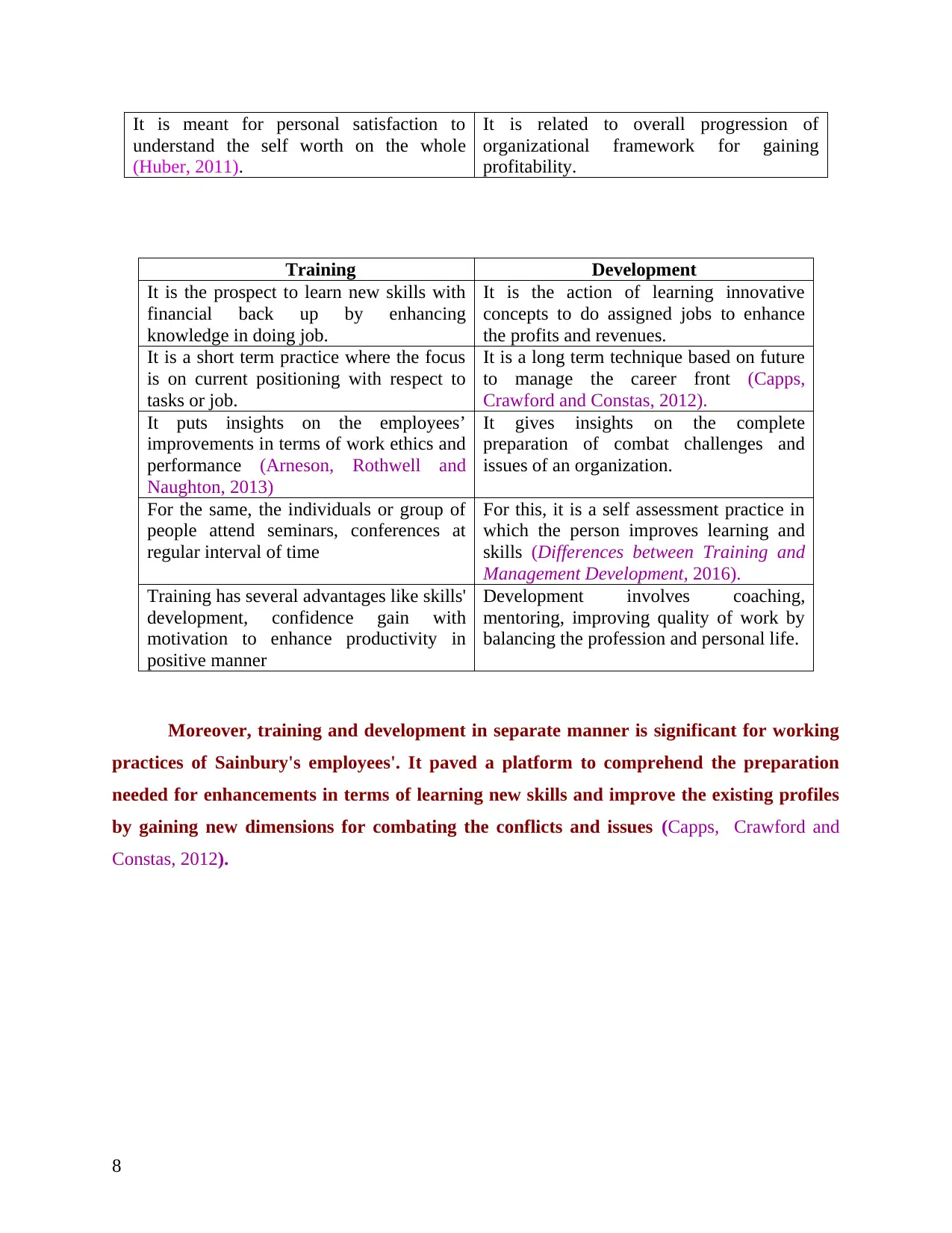
It is meant for personal satisfaction to
understand the self worth on the whole
(Huber, 2011).
It is related to overall progression of
organizational framework for gaining
profitability.
Training Development
It is the prospect to learn new skills with
financial back up by enhancing
knowledge in doing job.
It is the action of learning innovative
concepts to do assigned jobs to enhance
the profits and revenues.
It is a short term practice where the focus
is on current positioning with respect to
tasks or job.
It is a long term technique based on future
to manage the career front (Capps,
Crawford and Constas, 2012).
It puts insights on the employees’
improvements in terms of work ethics and
performance (Arneson, Rothwell and
Naughton, 2013)
It gives insights on the complete
preparation of combat challenges and
issues of an organization.
For the same, the individuals or group of
people attend seminars, conferences at
regular interval of time
For this, it is a self assessment practice in
which the person improves learning and
skills (Differences between Training and
Management Development, 2016).
Training has several advantages like skills'
development, confidence gain with
motivation to enhance productivity in
positive manner
Development involves coaching,
mentoring, improving quality of work by
balancing the profession and personal life.
Moreover, training and development in separate manner is significant for working
practices of Sainbury's employees'. It paved a platform to comprehend the preparation
needed for enhancements in terms of learning new skills and improve the existing profiles
by gaining new dimensions for combating the conflicts and issues (Capps, Crawford and
Constas, 2012).
8
understand the self worth on the whole
(Huber, 2011).
It is related to overall progression of
organizational framework for gaining
profitability.
Training Development
It is the prospect to learn new skills with
financial back up by enhancing
knowledge in doing job.
It is the action of learning innovative
concepts to do assigned jobs to enhance
the profits and revenues.
It is a short term practice where the focus
is on current positioning with respect to
tasks or job.
It is a long term technique based on future
to manage the career front (Capps,
Crawford and Constas, 2012).
It puts insights on the employees’
improvements in terms of work ethics and
performance (Arneson, Rothwell and
Naughton, 2013)
It gives insights on the complete
preparation of combat challenges and
issues of an organization.
For the same, the individuals or group of
people attend seminars, conferences at
regular interval of time
For this, it is a self assessment practice in
which the person improves learning and
skills (Differences between Training and
Management Development, 2016).
Training has several advantages like skills'
development, confidence gain with
motivation to enhance productivity in
positive manner
Development involves coaching,
mentoring, improving quality of work by
balancing the profession and personal life.
Moreover, training and development in separate manner is significant for working
practices of Sainbury's employees'. It paved a platform to comprehend the preparation
needed for enhancements in terms of learning new skills and improve the existing profiles
by gaining new dimensions for combating the conflicts and issues (Capps, Crawford and
Constas, 2012).
8
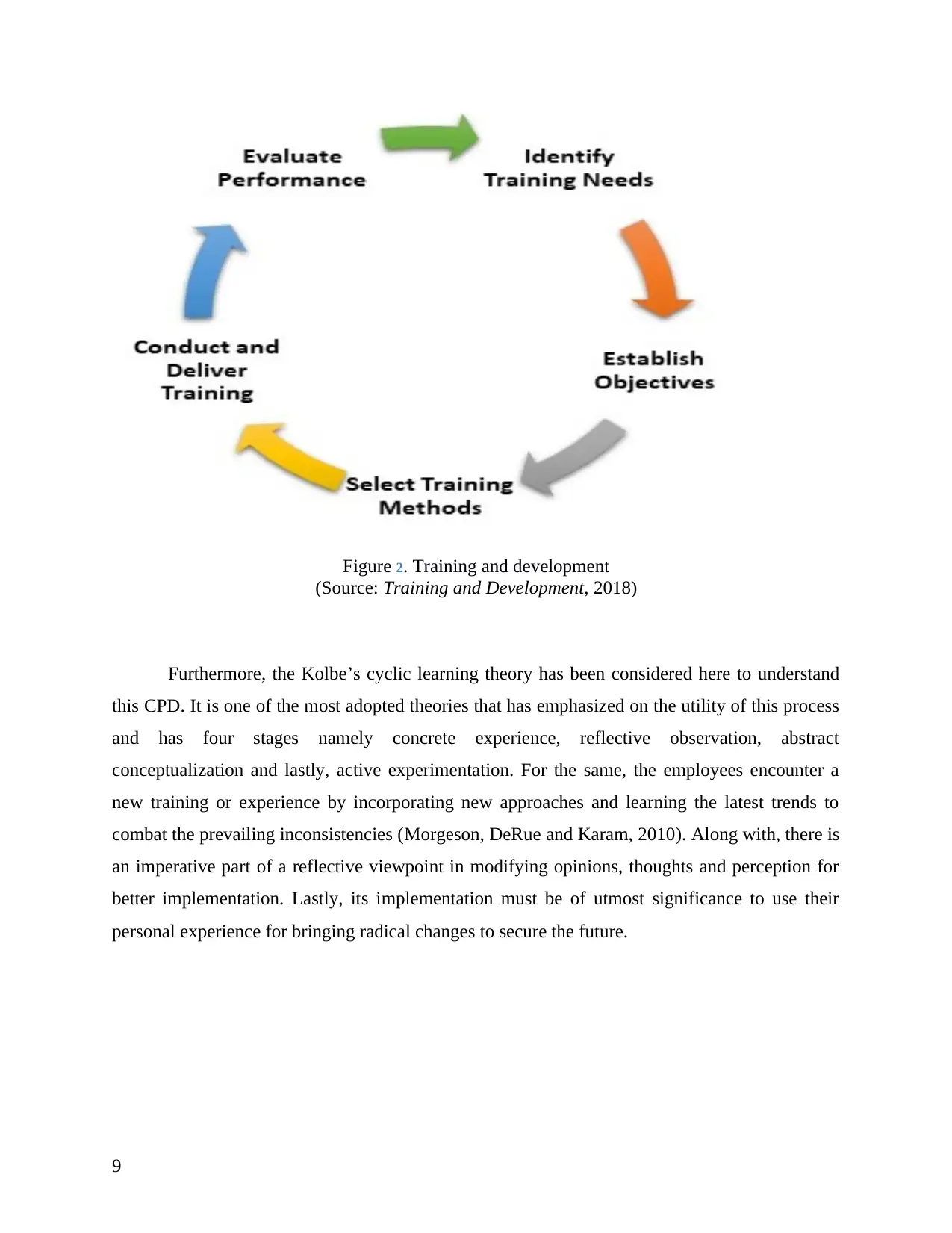
Figure 2. Training and development
(Source: Training and Development, 2018)
Furthermore, the Kolbe’s cyclic learning theory has been considered here to understand
this CPD. It is one of the most adopted theories that has emphasized on the utility of this process
and has four stages namely concrete experience, reflective observation, abstract
conceptualization and lastly, active experimentation. For the same, the employees encounter a
new training or experience by incorporating new approaches and learning the latest trends to
combat the prevailing inconsistencies (Morgeson, DeRue and Karam, 2010). Along with, there is
an imperative part of a reflective viewpoint in modifying opinions, thoughts and perception for
better implementation. Lastly, its implementation must be of utmost significance to use their
personal experience for bringing radical changes to secure the future.
9
(Source: Training and Development, 2018)
Furthermore, the Kolbe’s cyclic learning theory has been considered here to understand
this CPD. It is one of the most adopted theories that has emphasized on the utility of this process
and has four stages namely concrete experience, reflective observation, abstract
conceptualization and lastly, active experimentation. For the same, the employees encounter a
new training or experience by incorporating new approaches and learning the latest trends to
combat the prevailing inconsistencies (Morgeson, DeRue and Karam, 2010). Along with, there is
an imperative part of a reflective viewpoint in modifying opinions, thoughts and perception for
better implementation. Lastly, its implementation must be of utmost significance to use their
personal experience for bringing radical changes to secure the future.
9
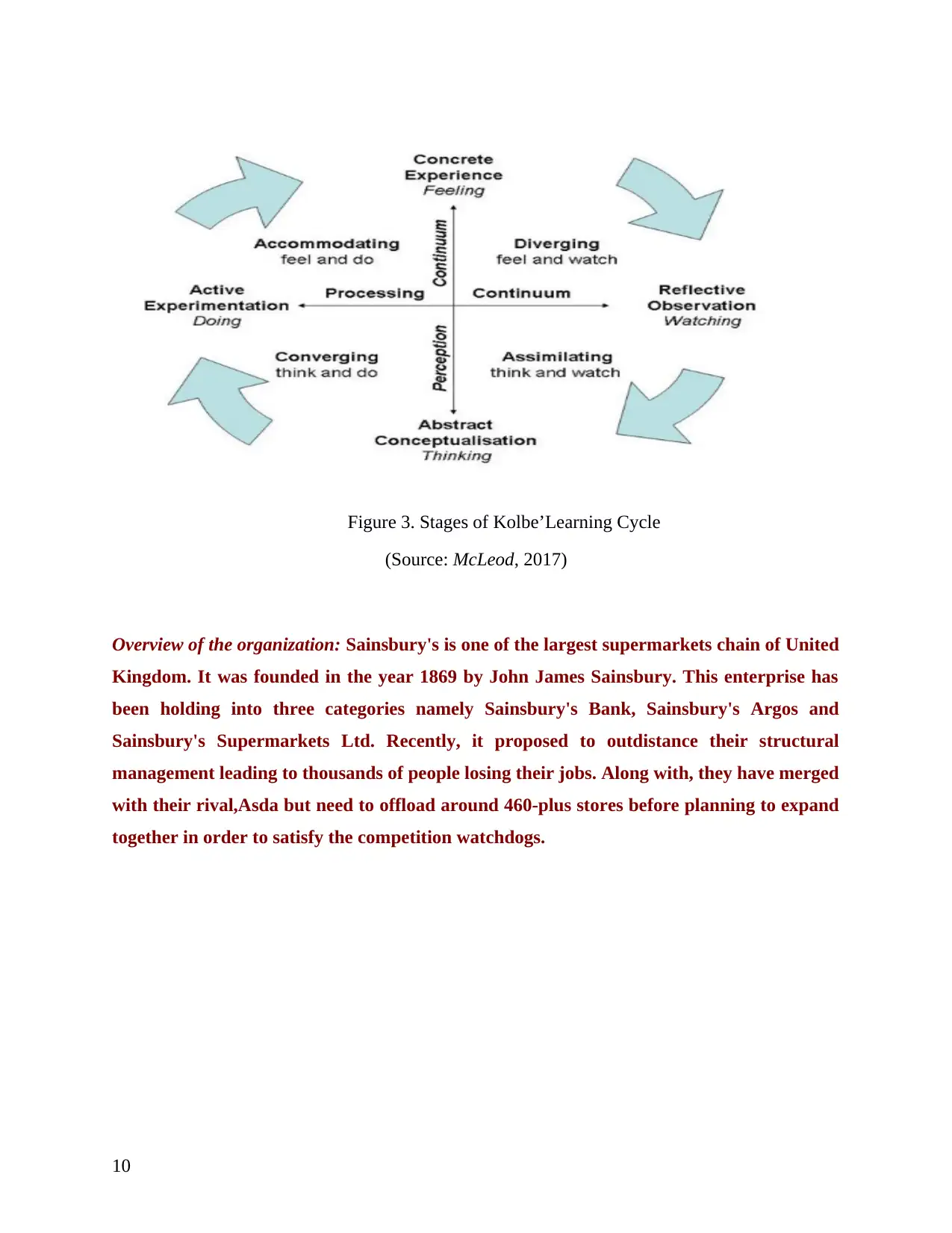
Figure 3. Stages of Kolbe’Learning Cycle
(Source: McLeod, 2017)
Overview of the organization: Sainsbury's is one of the largest supermarkets chain of United
Kingdom. It was founded in the year 1869 by John James Sainsbury. This enterprise has
been holding into three categories namely Sainsbury's Bank, Sainsbury's Argos and
Sainsbury's Supermarkets Ltd. Recently, it proposed to outdistance their structural
management leading to thousands of people losing their jobs. Along with, they have merged
with their rival,Asda but need to offload around 460-plus stores before planning to expand
together in order to satisfy the competition watchdogs.
10
(Source: McLeod, 2017)
Overview of the organization: Sainsbury's is one of the largest supermarkets chain of United
Kingdom. It was founded in the year 1869 by John James Sainsbury. This enterprise has
been holding into three categories namely Sainsbury's Bank, Sainsbury's Argos and
Sainsbury's Supermarkets Ltd. Recently, it proposed to outdistance their structural
management leading to thousands of people losing their jobs. Along with, they have merged
with their rival,Asda but need to offload around 460-plus stores before planning to expand
together in order to satisfy the competition watchdogs.
10
Secure Best Marks with AI Grader
Need help grading? Try our AI Grader for instant feedback on your assignments.

P4. Continuous learning and professional development to drive sustainable business performance
It is defined as the procedure of record keeping with supervision of employees’ skills,
knowledge and experience which are gained from both types of outlook such as formally and
informally. With this rise of need for continuous learning, there must be an understanding the
importance of performance metrics for pushing the sustainable aspect in an organization; here at
Sainsbury's has been considered. Also, the benefits of this professional development consist of
amplified participation to attain self-efficacy with continual learning in an integrated
collaborative approachability amongst the employees.
Moreover, it has become an integral part to understand CPD (continuous professional
development) that support in the increased productivity and employees’ retention rate at
Sainsbury's. In regard to the same, there are analyses that help in the identification and
evaluation of competencies with respect to specialist and generalist roles that must be swapped to
11
Illustration 1: Merger details between
Sainsbury's and Asda
(Source:Sainsbury's-Asda merger:
Competition probe begins,2018)
It is defined as the procedure of record keeping with supervision of employees’ skills,
knowledge and experience which are gained from both types of outlook such as formally and
informally. With this rise of need for continuous learning, there must be an understanding the
importance of performance metrics for pushing the sustainable aspect in an organization; here at
Sainsbury's has been considered. Also, the benefits of this professional development consist of
amplified participation to attain self-efficacy with continual learning in an integrated
collaborative approachability amongst the employees.
Moreover, it has become an integral part to understand CPD (continuous professional
development) that support in the increased productivity and employees’ retention rate at
Sainsbury's. In regard to the same, there are analyses that help in the identification and
evaluation of competencies with respect to specialist and generalist roles that must be swapped to
11
Illustration 1: Merger details between
Sainsbury's and Asda
(Source:Sainsbury's-Asda merger:
Competition probe begins,2018)
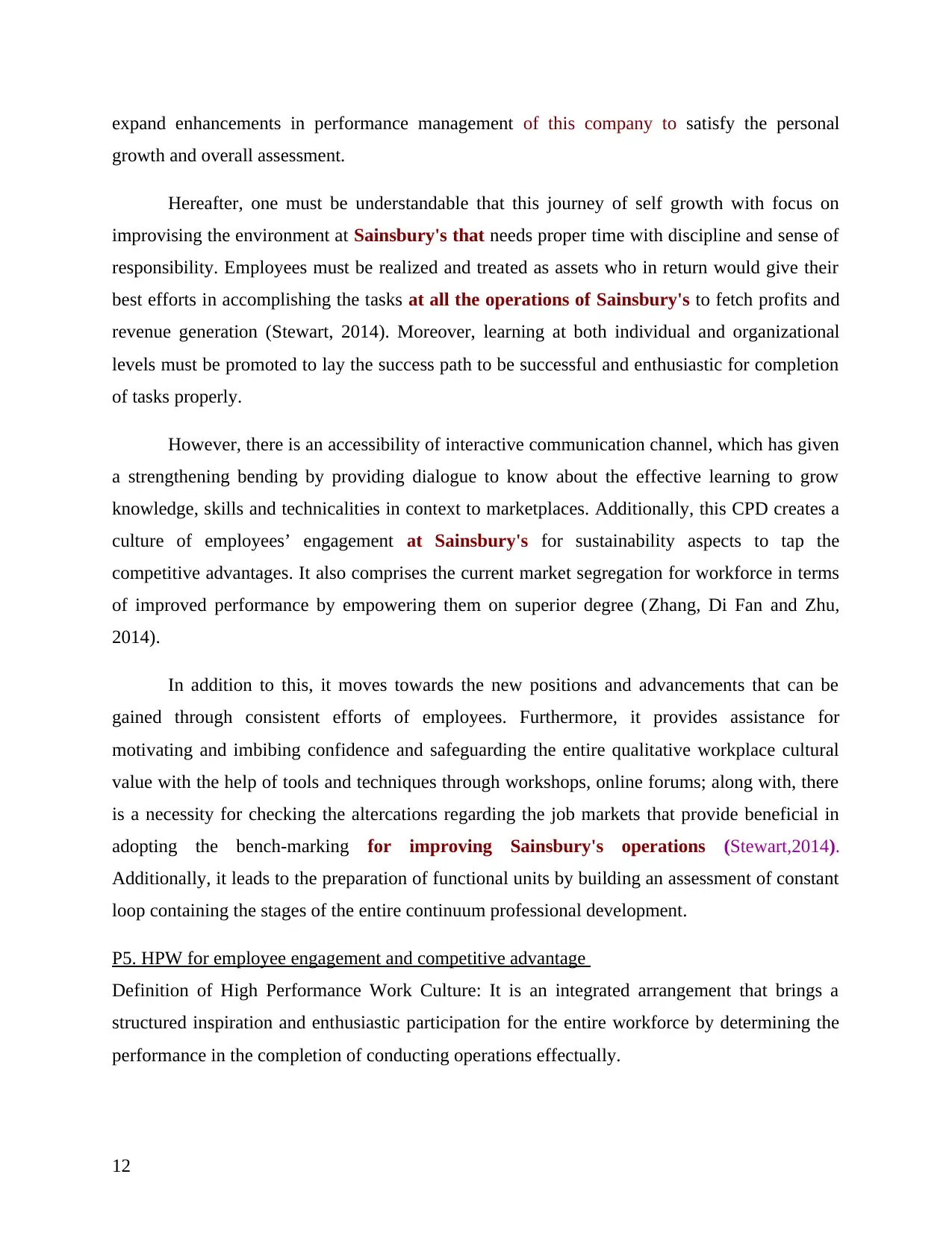
expand enhancements in performance management of this company to satisfy the personal
growth and overall assessment.
Hereafter, one must be understandable that this journey of self growth with focus on
improvising the environment at Sainsbury's that needs proper time with discipline and sense of
responsibility. Employees must be realized and treated as assets who in return would give their
best efforts in accomplishing the tasks at all the operations of Sainsbury's to fetch profits and
revenue generation (Stewart, 2014). Moreover, learning at both individual and organizational
levels must be promoted to lay the success path to be successful and enthusiastic for completion
of tasks properly.
However, there is an accessibility of interactive communication channel, which has given
a strengthening bending by providing dialogue to know about the effective learning to grow
knowledge, skills and technicalities in context to marketplaces. Additionally, this CPD creates a
culture of employees’ engagement at Sainsbury's for sustainability aspects to tap the
competitive advantages. It also comprises the current market segregation for workforce in terms
of improved performance by empowering them on superior degree (Zhang, Di Fan and Zhu,
2014).
In addition to this, it moves towards the new positions and advancements that can be
gained through consistent efforts of employees. Furthermore, it provides assistance for
motivating and imbibing confidence and safeguarding the entire qualitative workplace cultural
value with the help of tools and techniques through workshops, online forums; along with, there
is a necessity for checking the altercations regarding the job markets that provide beneficial in
adopting the bench-marking for improving Sainsbury's operations (Stewart,2014).
Additionally, it leads to the preparation of functional units by building an assessment of constant
loop containing the stages of the entire continuum professional development.
P5. HPW for employee engagement and competitive advantage
Definition of High Performance Work Culture: It is an integrated arrangement that brings a
structured inspiration and enthusiastic participation for the entire workforce by determining the
performance in the completion of conducting operations effectually.
12
growth and overall assessment.
Hereafter, one must be understandable that this journey of self growth with focus on
improvising the environment at Sainsbury's that needs proper time with discipline and sense of
responsibility. Employees must be realized and treated as assets who in return would give their
best efforts in accomplishing the tasks at all the operations of Sainsbury's to fetch profits and
revenue generation (Stewart, 2014). Moreover, learning at both individual and organizational
levels must be promoted to lay the success path to be successful and enthusiastic for completion
of tasks properly.
However, there is an accessibility of interactive communication channel, which has given
a strengthening bending by providing dialogue to know about the effective learning to grow
knowledge, skills and technicalities in context to marketplaces. Additionally, this CPD creates a
culture of employees’ engagement at Sainsbury's for sustainability aspects to tap the
competitive advantages. It also comprises the current market segregation for workforce in terms
of improved performance by empowering them on superior degree (Zhang, Di Fan and Zhu,
2014).
In addition to this, it moves towards the new positions and advancements that can be
gained through consistent efforts of employees. Furthermore, it provides assistance for
motivating and imbibing confidence and safeguarding the entire qualitative workplace cultural
value with the help of tools and techniques through workshops, online forums; along with, there
is a necessity for checking the altercations regarding the job markets that provide beneficial in
adopting the bench-marking for improving Sainsbury's operations (Stewart,2014).
Additionally, it leads to the preparation of functional units by building an assessment of constant
loop containing the stages of the entire continuum professional development.
P5. HPW for employee engagement and competitive advantage
Definition of High Performance Work Culture: It is an integrated arrangement that brings a
structured inspiration and enthusiastic participation for the entire workforce by determining the
performance in the completion of conducting operations effectually.
12
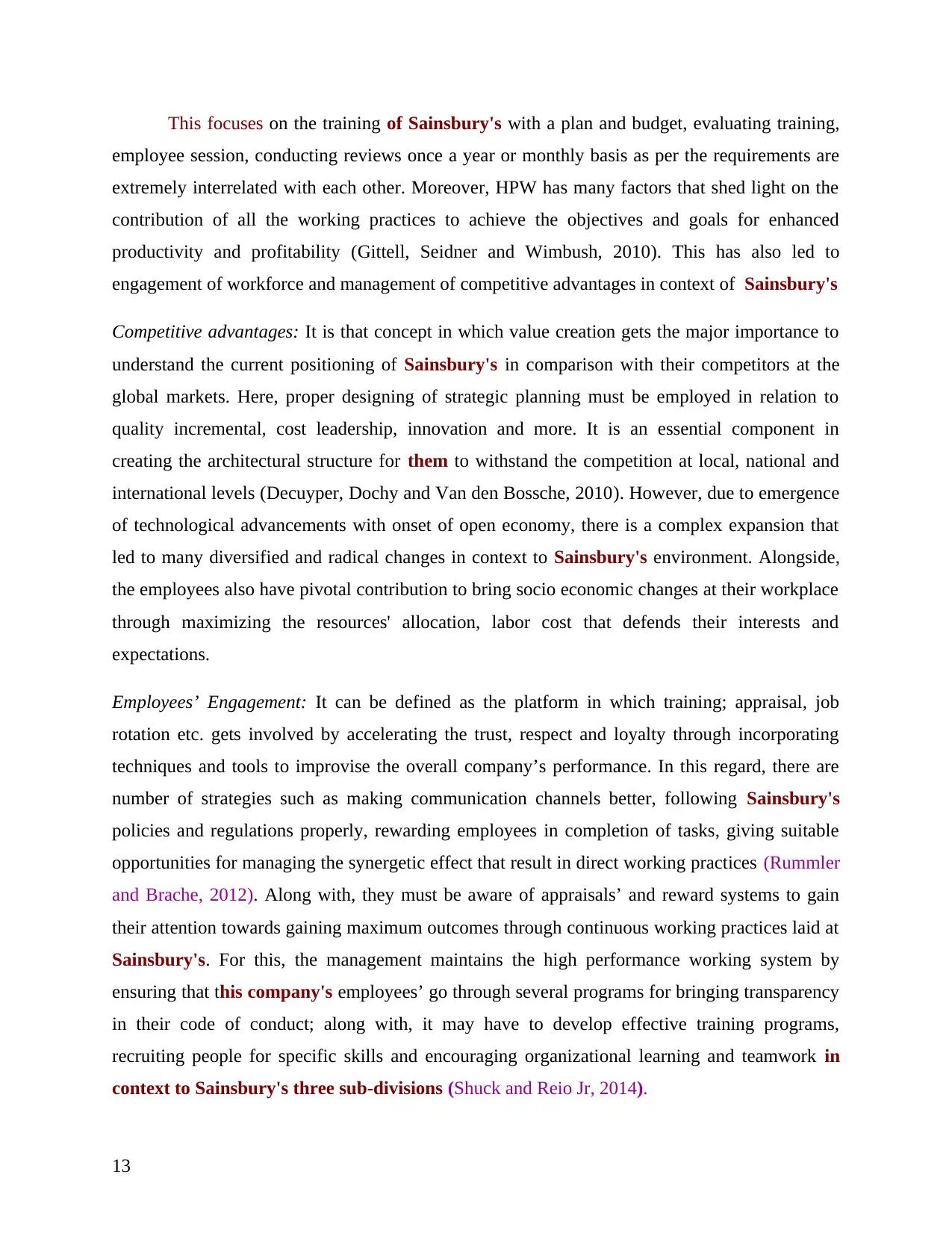
This focuses on the training of Sainsbury's with a plan and budget, evaluating training,
employee session, conducting reviews once a year or monthly basis as per the requirements are
extremely interrelated with each other. Moreover, HPW has many factors that shed light on the
contribution of all the working practices to achieve the objectives and goals for enhanced
productivity and profitability (Gittell, Seidner and Wimbush, 2010). This has also led to
engagement of workforce and management of competitive advantages in context of Sainsbury's
Competitive advantages: It is that concept in which value creation gets the major importance to
understand the current positioning of Sainsbury's in comparison with their competitors at the
global markets. Here, proper designing of strategic planning must be employed in relation to
quality incremental, cost leadership, innovation and more. It is an essential component in
creating the architectural structure for them to withstand the competition at local, national and
international levels (Decuyper, Dochy and Van den Bossche, 2010). However, due to emergence
of technological advancements with onset of open economy, there is a complex expansion that
led to many diversified and radical changes in context to Sainsbury's environment. Alongside,
the employees also have pivotal contribution to bring socio economic changes at their workplace
through maximizing the resources' allocation, labor cost that defends their interests and
expectations.
Employees’ Engagement: It can be defined as the platform in which training; appraisal, job
rotation etc. gets involved by accelerating the trust, respect and loyalty through incorporating
techniques and tools to improvise the overall company’s performance. In this regard, there are
number of strategies such as making communication channels better, following Sainsbury's
policies and regulations properly, rewarding employees in completion of tasks, giving suitable
opportunities for managing the synergetic effect that result in direct working practices (Rummler
and Brache, 2012). Along with, they must be aware of appraisals’ and reward systems to gain
their attention towards gaining maximum outcomes through continuous working practices laid at
Sainsbury's. For this, the management maintains the high performance working system by
ensuring that this company's employees’ go through several programs for bringing transparency
in their code of conduct; along with, it may have to develop effective training programs,
recruiting people for specific skills and encouraging organizational learning and teamwork in
context to Sainsbury's three sub-divisions (Shuck and Reio Jr, 2014).
13
employee session, conducting reviews once a year or monthly basis as per the requirements are
extremely interrelated with each other. Moreover, HPW has many factors that shed light on the
contribution of all the working practices to achieve the objectives and goals for enhanced
productivity and profitability (Gittell, Seidner and Wimbush, 2010). This has also led to
engagement of workforce and management of competitive advantages in context of Sainsbury's
Competitive advantages: It is that concept in which value creation gets the major importance to
understand the current positioning of Sainsbury's in comparison with their competitors at the
global markets. Here, proper designing of strategic planning must be employed in relation to
quality incremental, cost leadership, innovation and more. It is an essential component in
creating the architectural structure for them to withstand the competition at local, national and
international levels (Decuyper, Dochy and Van den Bossche, 2010). However, due to emergence
of technological advancements with onset of open economy, there is a complex expansion that
led to many diversified and radical changes in context to Sainsbury's environment. Alongside,
the employees also have pivotal contribution to bring socio economic changes at their workplace
through maximizing the resources' allocation, labor cost that defends their interests and
expectations.
Employees’ Engagement: It can be defined as the platform in which training; appraisal, job
rotation etc. gets involved by accelerating the trust, respect and loyalty through incorporating
techniques and tools to improvise the overall company’s performance. In this regard, there are
number of strategies such as making communication channels better, following Sainsbury's
policies and regulations properly, rewarding employees in completion of tasks, giving suitable
opportunities for managing the synergetic effect that result in direct working practices (Rummler
and Brache, 2012). Along with, they must be aware of appraisals’ and reward systems to gain
their attention towards gaining maximum outcomes through continuous working practices laid at
Sainsbury's. For this, the management maintains the high performance working system by
ensuring that this company's employees’ go through several programs for bringing transparency
in their code of conduct; along with, it may have to develop effective training programs,
recruiting people for specific skills and encouraging organizational learning and teamwork in
context to Sainsbury's three sub-divisions (Shuck and Reio Jr, 2014).
13
Paraphrase This Document
Need a fresh take? Get an instant paraphrase of this document with our AI Paraphraser
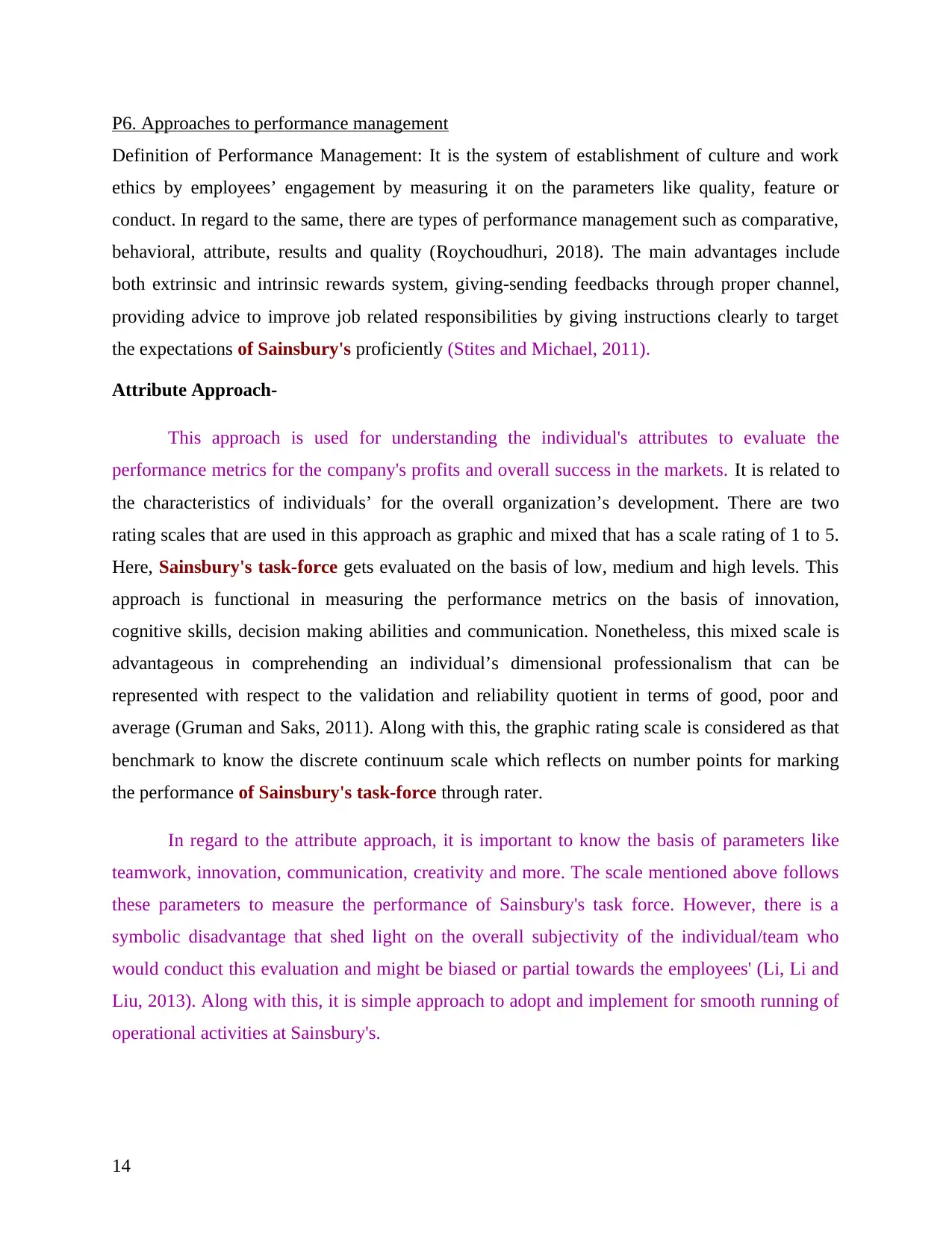
P6. Approaches to performance management
Definition of Performance Management: It is the system of establishment of culture and work
ethics by employees’ engagement by measuring it on the parameters like quality, feature or
conduct. In regard to the same, there are types of performance management such as comparative,
behavioral, attribute, results and quality (Roychoudhuri, 2018). The main advantages include
both extrinsic and intrinsic rewards system, giving-sending feedbacks through proper channel,
providing advice to improve job related responsibilities by giving instructions clearly to target
the expectations of Sainsbury's proficiently (Stites and Michael, 2011).
Attribute Approach-
This approach is used for understanding the individual's attributes to evaluate the
performance metrics for the company's profits and overall success in the markets. It is related to
the characteristics of individuals’ for the overall organization’s development. There are two
rating scales that are used in this approach as graphic and mixed that has a scale rating of 1 to 5.
Here, Sainsbury's task-force gets evaluated on the basis of low, medium and high levels. This
approach is functional in measuring the performance metrics on the basis of innovation,
cognitive skills, decision making abilities and communication. Nonetheless, this mixed scale is
advantageous in comprehending an individual’s dimensional professionalism that can be
represented with respect to the validation and reliability quotient in terms of good, poor and
average (Gruman and Saks, 2011). Along with this, the graphic rating scale is considered as that
benchmark to know the discrete continuum scale which reflects on number points for marking
the performance of Sainsbury's task-force through rater.
In regard to the attribute approach, it is important to know the basis of parameters like
teamwork, innovation, communication, creativity and more. The scale mentioned above follows
these parameters to measure the performance of Sainsbury's task force. However, there is a
symbolic disadvantage that shed light on the overall subjectivity of the individual/team who
would conduct this evaluation and might be biased or partial towards the employees' (Li, Li and
Liu, 2013). Along with this, it is simple approach to adopt and implement for smooth running of
operational activities at Sainsbury's.
14
Definition of Performance Management: It is the system of establishment of culture and work
ethics by employees’ engagement by measuring it on the parameters like quality, feature or
conduct. In regard to the same, there are types of performance management such as comparative,
behavioral, attribute, results and quality (Roychoudhuri, 2018). The main advantages include
both extrinsic and intrinsic rewards system, giving-sending feedbacks through proper channel,
providing advice to improve job related responsibilities by giving instructions clearly to target
the expectations of Sainsbury's proficiently (Stites and Michael, 2011).
Attribute Approach-
This approach is used for understanding the individual's attributes to evaluate the
performance metrics for the company's profits and overall success in the markets. It is related to
the characteristics of individuals’ for the overall organization’s development. There are two
rating scales that are used in this approach as graphic and mixed that has a scale rating of 1 to 5.
Here, Sainsbury's task-force gets evaluated on the basis of low, medium and high levels. This
approach is functional in measuring the performance metrics on the basis of innovation,
cognitive skills, decision making abilities and communication. Nonetheless, this mixed scale is
advantageous in comprehending an individual’s dimensional professionalism that can be
represented with respect to the validation and reliability quotient in terms of good, poor and
average (Gruman and Saks, 2011). Along with this, the graphic rating scale is considered as that
benchmark to know the discrete continuum scale which reflects on number points for marking
the performance of Sainsbury's task-force through rater.
In regard to the attribute approach, it is important to know the basis of parameters like
teamwork, innovation, communication, creativity and more. The scale mentioned above follows
these parameters to measure the performance of Sainsbury's task force. However, there is a
symbolic disadvantage that shed light on the overall subjectivity of the individual/team who
would conduct this evaluation and might be biased or partial towards the employees' (Li, Li and
Liu, 2013). Along with this, it is simple approach to adopt and implement for smooth running of
operational activities at Sainsbury's.
14
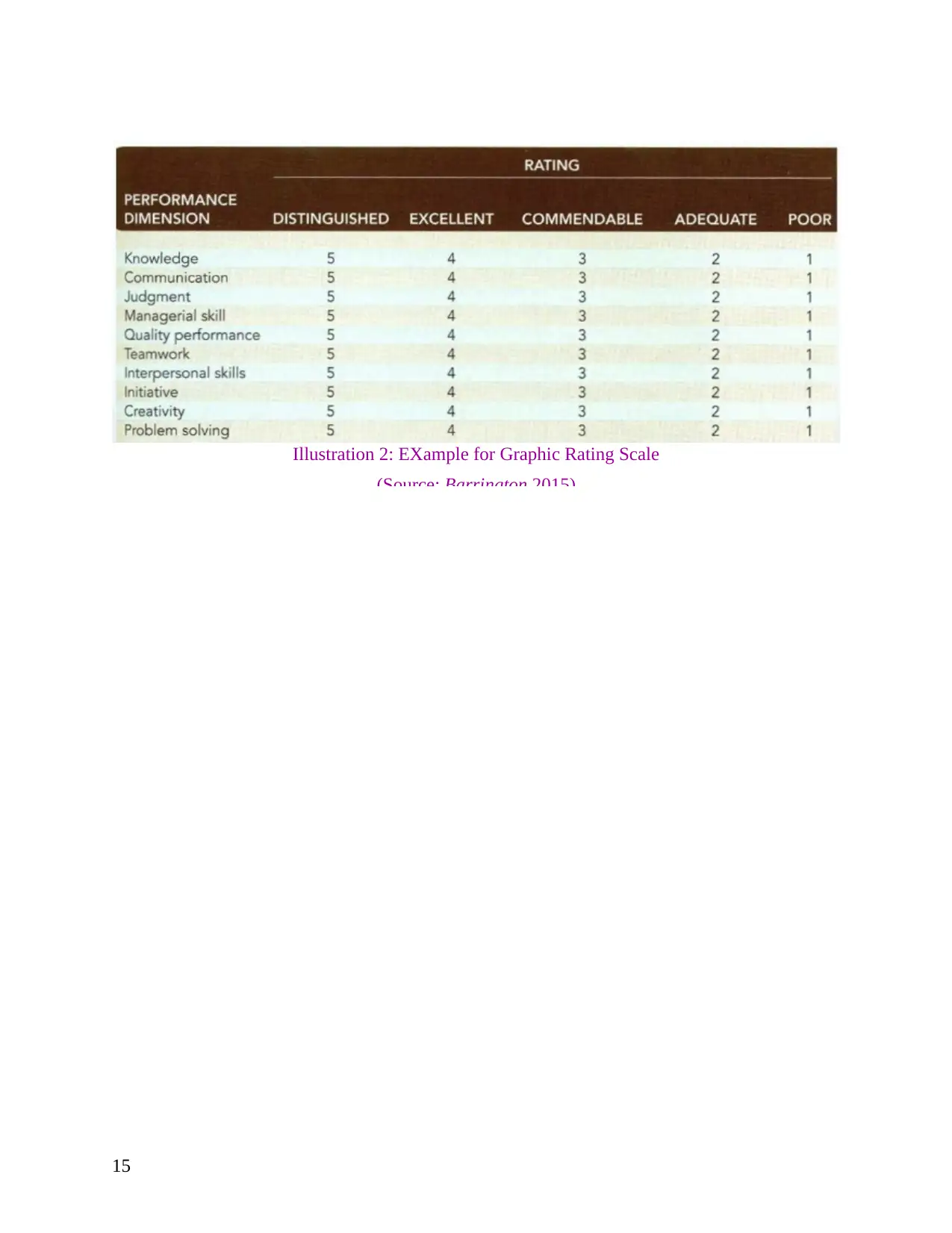
15
Illustration 2: EXample for Graphic Rating Scale
(Source: Barrington,2015)
Illustration 2: EXample for Graphic Rating Scale
(Source: Barrington,2015)
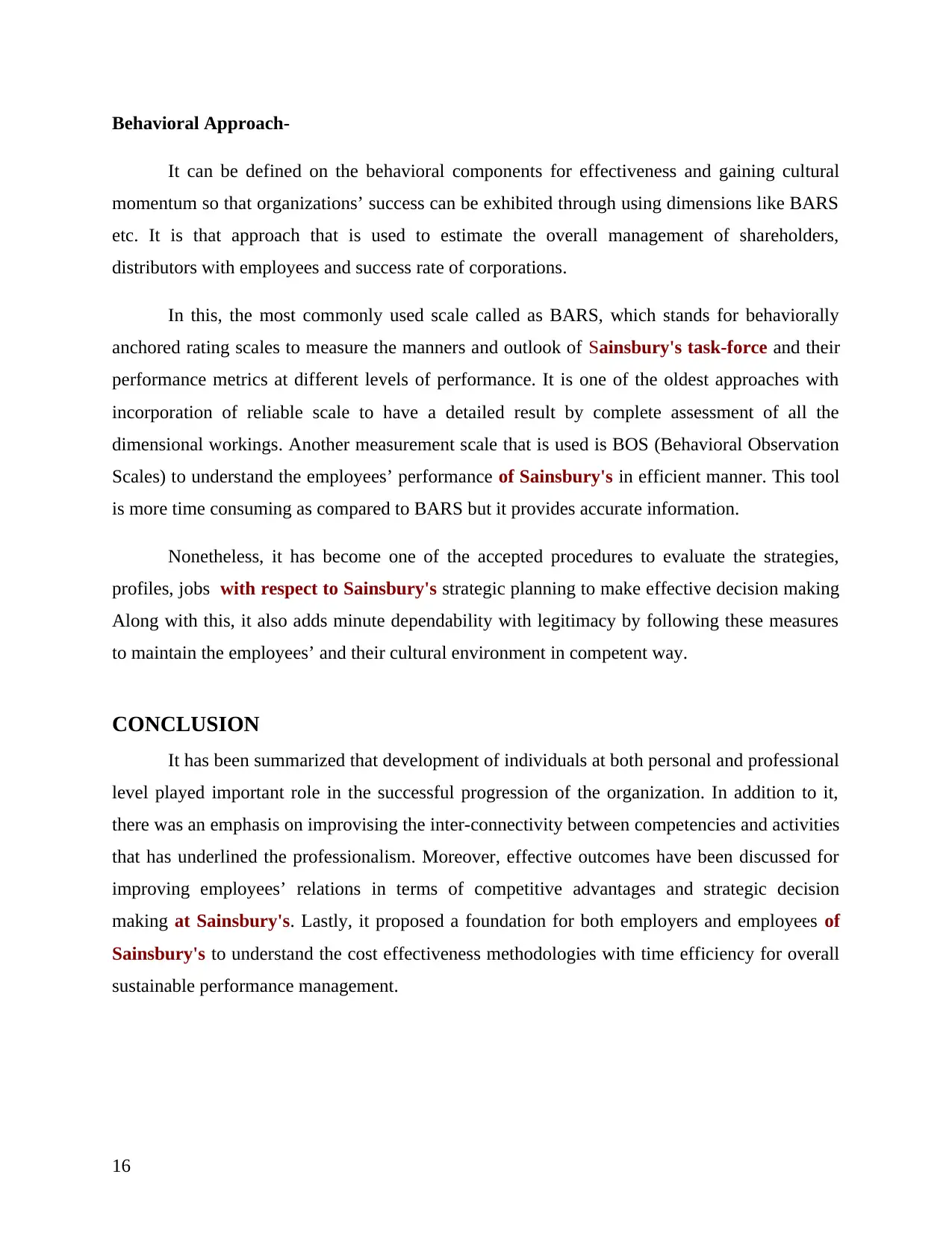
Behavioral Approach-
It can be defined on the behavioral components for effectiveness and gaining cultural
momentum so that organizations’ success can be exhibited through using dimensions like BARS
etc. It is that approach that is used to estimate the overall management of shareholders,
distributors with employees and success rate of corporations.
In this, the most commonly used scale called as BARS, which stands for behaviorally
anchored rating scales to measure the manners and outlook of Sainsbury's task-force and their
performance metrics at different levels of performance. It is one of the oldest approaches with
incorporation of reliable scale to have a detailed result by complete assessment of all the
dimensional workings. Another measurement scale that is used is BOS (Behavioral Observation
Scales) to understand the employees’ performance of Sainsbury's in efficient manner. This tool
is more time consuming as compared to BARS but it provides accurate information.
Nonetheless, it has become one of the accepted procedures to evaluate the strategies,
profiles, jobs with respect to Sainsbury's strategic planning to make effective decision making
Along with this, it also adds minute dependability with legitimacy by following these measures
to maintain the employees’ and their cultural environment in competent way.
CONCLUSION
It has been summarized that development of individuals at both personal and professional
level played important role in the successful progression of the organization. In addition to it,
there was an emphasis on improvising the inter-connectivity between competencies and activities
that has underlined the professionalism. Moreover, effective outcomes have been discussed for
improving employees’ relations in terms of competitive advantages and strategic decision
making at Sainsbury's. Lastly, it proposed a foundation for both employers and employees of
Sainsbury's to understand the cost effectiveness methodologies with time efficiency for overall
sustainable performance management.
16
It can be defined on the behavioral components for effectiveness and gaining cultural
momentum so that organizations’ success can be exhibited through using dimensions like BARS
etc. It is that approach that is used to estimate the overall management of shareholders,
distributors with employees and success rate of corporations.
In this, the most commonly used scale called as BARS, which stands for behaviorally
anchored rating scales to measure the manners and outlook of Sainsbury's task-force and their
performance metrics at different levels of performance. It is one of the oldest approaches with
incorporation of reliable scale to have a detailed result by complete assessment of all the
dimensional workings. Another measurement scale that is used is BOS (Behavioral Observation
Scales) to understand the employees’ performance of Sainsbury's in efficient manner. This tool
is more time consuming as compared to BARS but it provides accurate information.
Nonetheless, it has become one of the accepted procedures to evaluate the strategies,
profiles, jobs with respect to Sainsbury's strategic planning to make effective decision making
Along with this, it also adds minute dependability with legitimacy by following these measures
to maintain the employees’ and their cultural environment in competent way.
CONCLUSION
It has been summarized that development of individuals at both personal and professional
level played important role in the successful progression of the organization. In addition to it,
there was an emphasis on improvising the inter-connectivity between competencies and activities
that has underlined the professionalism. Moreover, effective outcomes have been discussed for
improving employees’ relations in terms of competitive advantages and strategic decision
making at Sainsbury's. Lastly, it proposed a foundation for both employers and employees of
Sainsbury's to understand the cost effectiveness methodologies with time efficiency for overall
sustainable performance management.
16
Secure Best Marks with AI Grader
Need help grading? Try our AI Grader for instant feedback on your assignments.

REFERENCES
Books and Journals
Arneson, J., Rothwell, W. and Naughton, J., 2013. Training and development competencies
redefined to create competitive advantage.T and D.67(1). pp.42-47.
Belbin, R.M., 2012. Team roles at work. Routledge.
Bolden, R., 2016. Leadership, management and organisational development. In Gower handbook
of leadership and management development (pp. 143-158). Routledge.
Brockbank, W. and et.al., 2012. Recent study shows impact of HR competencies on business
performance. Employment Relations Today. 39(1). pp.1-7.
Capps, D.K., Crawford, B.A. and Constas, M.A., 2012. A review of empirical literature on
inquiry professional development: Alignment with best practices and a critique of the
findings.Journal of science teacher education.23(3) pp.291-318.
Decuyper, S., Dochy, F. and Van den Bossche, P., 2010. Grasping the dynamic complexity of
team learning: An integrative model for effective team learning in organisations. Educational
Research Review. 5(2). pp.111-133.
Gittell, J.H., Seidner, R. and Wimbush, J., 2010. A relational model of how high-performance
work systems work. Organization science. 21(2). pp.490-506.
Goetsch, D.L. and Davis, S.B., 2014. Quality management for organizational excellence. Upper
Saddle River, NJ: pearson.
Gruman, J.A. and Saks, A.M., 2011. Performance management and employee
engagement. Human Resource Management Review. 21(2). pp.123-136.
Guest, D.E., 2011. Human resource management and performance: still searching for some
answers. Human resource management journal. 21(1). pp.3-13.
Huber, S.G., 2011. Leadership for learning–Learning for leadership: The impact of professional
development. In International handbook of leadership for learning(pp. 635-652). Springer,
Dordrecht.
Jehanzeb, K. and Bashir, N.A., 2013. Training and development program and its benefits to
employee and organization: A conceptual study. European Journal of business and management.
5(2).
17
Books and Journals
Arneson, J., Rothwell, W. and Naughton, J., 2013. Training and development competencies
redefined to create competitive advantage.T and D.67(1). pp.42-47.
Belbin, R.M., 2012. Team roles at work. Routledge.
Bolden, R., 2016. Leadership, management and organisational development. In Gower handbook
of leadership and management development (pp. 143-158). Routledge.
Brockbank, W. and et.al., 2012. Recent study shows impact of HR competencies on business
performance. Employment Relations Today. 39(1). pp.1-7.
Capps, D.K., Crawford, B.A. and Constas, M.A., 2012. A review of empirical literature on
inquiry professional development: Alignment with best practices and a critique of the
findings.Journal of science teacher education.23(3) pp.291-318.
Decuyper, S., Dochy, F. and Van den Bossche, P., 2010. Grasping the dynamic complexity of
team learning: An integrative model for effective team learning in organisations. Educational
Research Review. 5(2). pp.111-133.
Gittell, J.H., Seidner, R. and Wimbush, J., 2010. A relational model of how high-performance
work systems work. Organization science. 21(2). pp.490-506.
Goetsch, D.L. and Davis, S.B., 2014. Quality management for organizational excellence. Upper
Saddle River, NJ: pearson.
Gruman, J.A. and Saks, A.M., 2011. Performance management and employee
engagement. Human Resource Management Review. 21(2). pp.123-136.
Guest, D.E., 2011. Human resource management and performance: still searching for some
answers. Human resource management journal. 21(1). pp.3-13.
Huber, S.G., 2011. Leadership for learning–Learning for leadership: The impact of professional
development. In International handbook of leadership for learning(pp. 635-652). Springer,
Dordrecht.
Jehanzeb, K. and Bashir, N.A., 2013. Training and development program and its benefits to
employee and organization: A conceptual study. European Journal of business and management.
5(2).
17
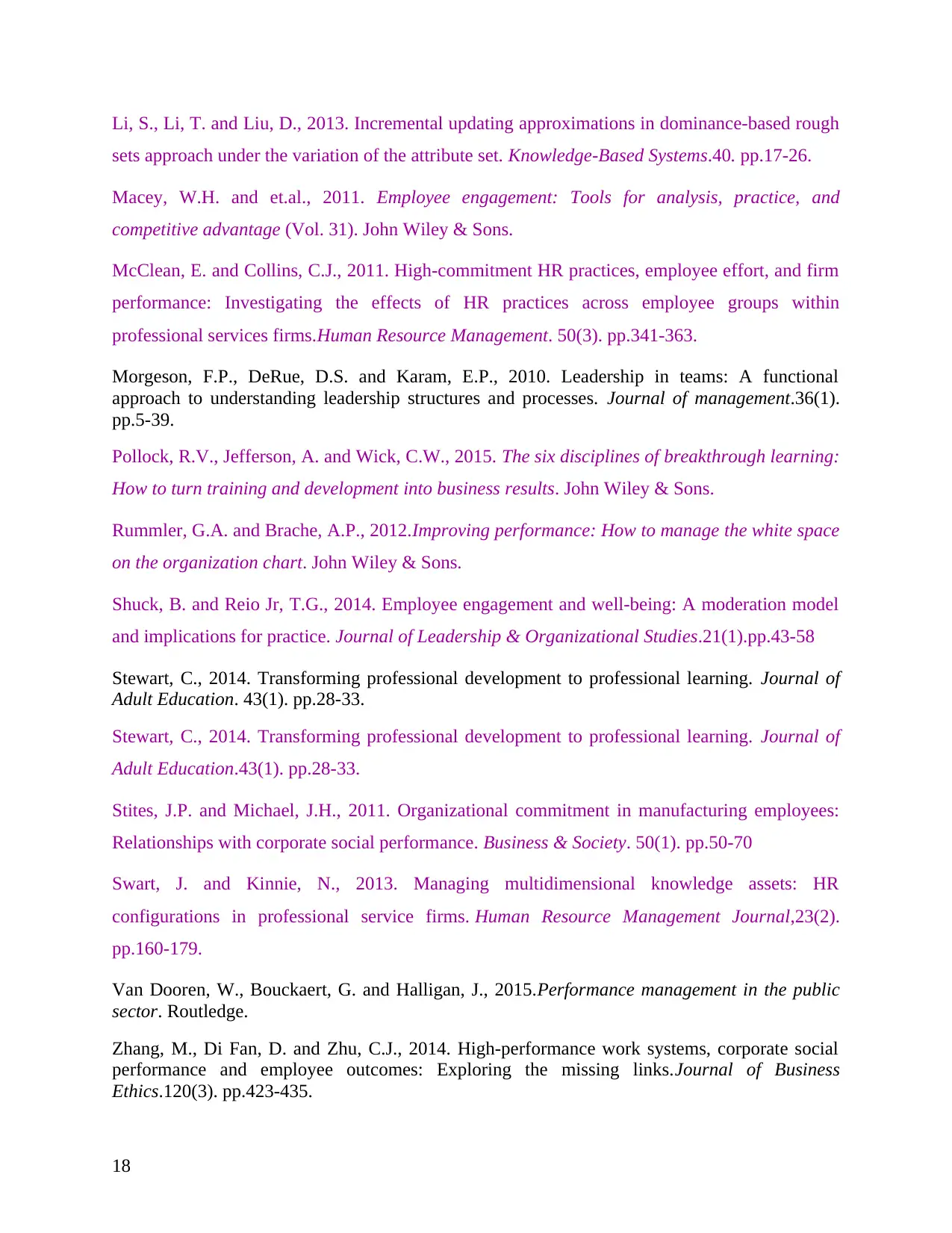
Li, S., Li, T. and Liu, D., 2013. Incremental updating approximations in dominance-based rough
sets approach under the variation of the attribute set. Knowledge-Based Systems.40. pp.17-26.
Macey, W.H. and et.al., 2011. Employee engagement: Tools for analysis, practice, and
competitive advantage (Vol. 31). John Wiley & Sons.
McClean, E. and Collins, C.J., 2011. High‐commitment HR practices, employee effort, and firm
performance: Investigating the effects of HR practices across employee groups within
professional services firms.Human Resource Management. 50(3). pp.341-363.
Morgeson, F.P., DeRue, D.S. and Karam, E.P., 2010. Leadership in teams: A functional
approach to understanding leadership structures and processes. Journal of management.36(1).
pp.5-39.
Pollock, R.V., Jefferson, A. and Wick, C.W., 2015. The six disciplines of breakthrough learning:
How to turn training and development into business results. John Wiley & Sons.
Rummler, G.A. and Brache, A.P., 2012.Improving performance: How to manage the white space
on the organization chart. John Wiley & Sons.
Shuck, B. and Reio Jr, T.G., 2014. Employee engagement and well-being: A moderation model
and implications for practice. Journal of Leadership & Organizational Studies.21(1).pp.43-58
Stewart, C., 2014. Transforming professional development to professional learning. Journal of
Adult Education. 43(1). pp.28-33.
Stewart, C., 2014. Transforming professional development to professional learning. Journal of
Adult Education.43(1). pp.28-33.
Stites, J.P. and Michael, J.H., 2011. Organizational commitment in manufacturing employees:
Relationships with corporate social performance. Business & Society. 50(1). pp.50-70
Swart, J. and Kinnie, N., 2013. Managing multidimensional knowledge assets: HR
configurations in professional service firms. Human Resource Management Journal,23(2).
pp.160-179.
Van Dooren, W., Bouckaert, G. and Halligan, J., 2015.Performance management in the public
sector. Routledge.
Zhang, M., Di Fan, D. and Zhu, C.J., 2014. High-performance work systems, corporate social
performance and employee outcomes: Exploring the missing links.Journal of Business
Ethics.120(3). pp.423-435.
18
sets approach under the variation of the attribute set. Knowledge-Based Systems.40. pp.17-26.
Macey, W.H. and et.al., 2011. Employee engagement: Tools for analysis, practice, and
competitive advantage (Vol. 31). John Wiley & Sons.
McClean, E. and Collins, C.J., 2011. High‐commitment HR practices, employee effort, and firm
performance: Investigating the effects of HR practices across employee groups within
professional services firms.Human Resource Management. 50(3). pp.341-363.
Morgeson, F.P., DeRue, D.S. and Karam, E.P., 2010. Leadership in teams: A functional
approach to understanding leadership structures and processes. Journal of management.36(1).
pp.5-39.
Pollock, R.V., Jefferson, A. and Wick, C.W., 2015. The six disciplines of breakthrough learning:
How to turn training and development into business results. John Wiley & Sons.
Rummler, G.A. and Brache, A.P., 2012.Improving performance: How to manage the white space
on the organization chart. John Wiley & Sons.
Shuck, B. and Reio Jr, T.G., 2014. Employee engagement and well-being: A moderation model
and implications for practice. Journal of Leadership & Organizational Studies.21(1).pp.43-58
Stewart, C., 2014. Transforming professional development to professional learning. Journal of
Adult Education. 43(1). pp.28-33.
Stewart, C., 2014. Transforming professional development to professional learning. Journal of
Adult Education.43(1). pp.28-33.
Stites, J.P. and Michael, J.H., 2011. Organizational commitment in manufacturing employees:
Relationships with corporate social performance. Business & Society. 50(1). pp.50-70
Swart, J. and Kinnie, N., 2013. Managing multidimensional knowledge assets: HR
configurations in professional service firms. Human Resource Management Journal,23(2).
pp.160-179.
Van Dooren, W., Bouckaert, G. and Halligan, J., 2015.Performance management in the public
sector. Routledge.
Zhang, M., Di Fan, D. and Zhu, C.J., 2014. High-performance work systems, corporate social
performance and employee outcomes: Exploring the missing links.Journal of Business
Ethics.120(3). pp.423-435.
18
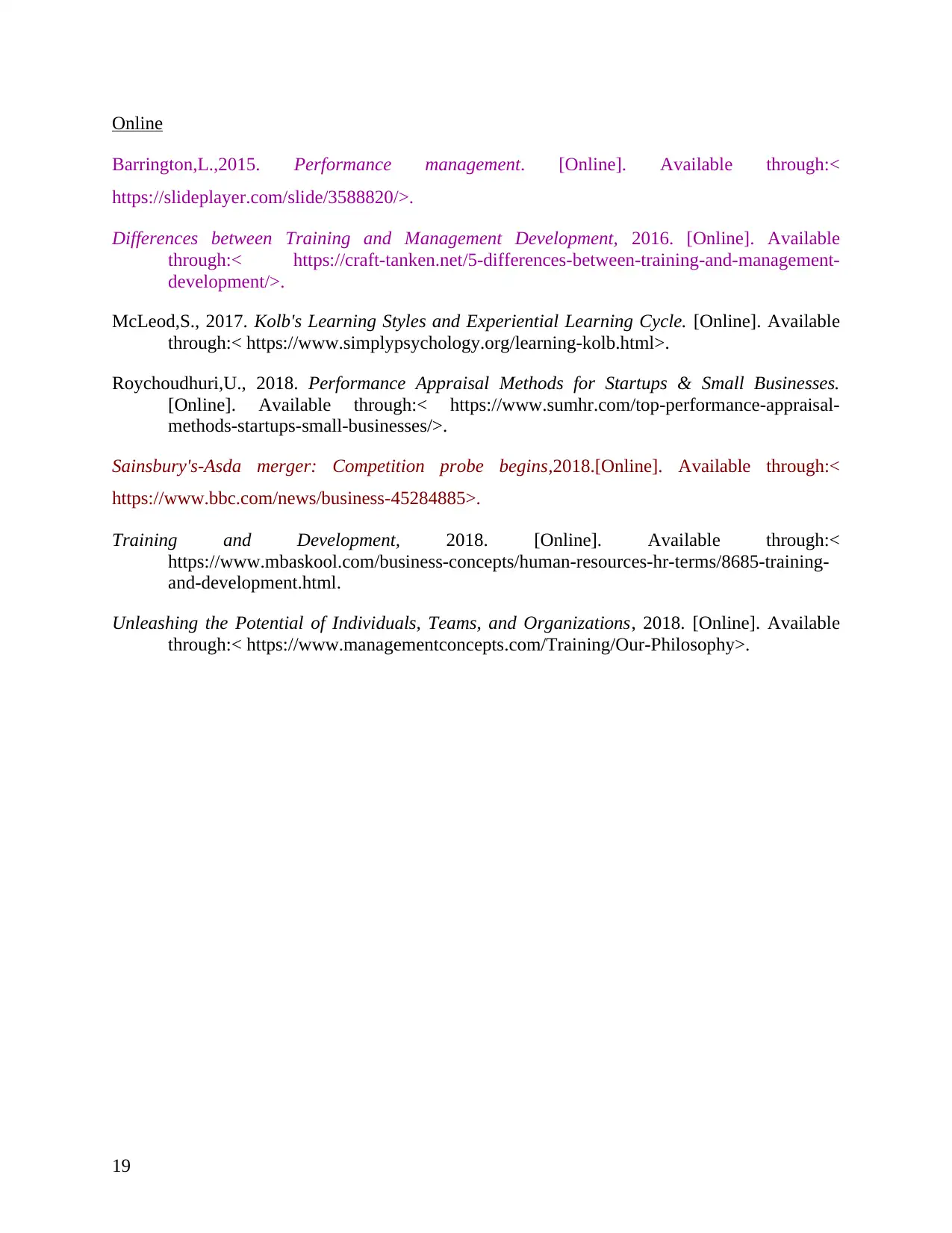
Online
Barrington,L.,2015. Performance management. [Online]. Available through:<
https://slideplayer.com/slide/3588820/>.
Differences between Training and Management Development, 2016. [Online]. Available
through:< https://craft-tanken.net/5-differences-between-training-and-management-
development/>.
McLeod,S., 2017. Kolb's Learning Styles and Experiential Learning Cycle. [Online]. Available
through:< https://www.simplypsychology.org/learning-kolb.html>.
Roychoudhuri,U., 2018. Performance Appraisal Methods for Startups & Small Businesses.
[Online]. Available through:< https://www.sumhr.com/top-performance-appraisal-
methods-startups-small-businesses/>.
Sainsbury's-Asda merger: Competition probe begins,2018.[Online]. Available through:<
https://www.bbc.com/news/business-45284885>.
Training and Development, 2018. [Online]. Available through:<
https://www.mbaskool.com/business-concepts/human-resources-hr-terms/8685-training-
and-development.html.
Unleashing the Potential of Individuals, Teams, and Organizations, 2018. [Online]. Available
through:< https://www.managementconcepts.com/Training/Our-Philosophy>.
19
Barrington,L.,2015. Performance management. [Online]. Available through:<
https://slideplayer.com/slide/3588820/>.
Differences between Training and Management Development, 2016. [Online]. Available
through:< https://craft-tanken.net/5-differences-between-training-and-management-
development/>.
McLeod,S., 2017. Kolb's Learning Styles and Experiential Learning Cycle. [Online]. Available
through:< https://www.simplypsychology.org/learning-kolb.html>.
Roychoudhuri,U., 2018. Performance Appraisal Methods for Startups & Small Businesses.
[Online]. Available through:< https://www.sumhr.com/top-performance-appraisal-
methods-startups-small-businesses/>.
Sainsbury's-Asda merger: Competition probe begins,2018.[Online]. Available through:<
https://www.bbc.com/news/business-45284885>.
Training and Development, 2018. [Online]. Available through:<
https://www.mbaskool.com/business-concepts/human-resources-hr-terms/8685-training-
and-development.html.
Unleashing the Potential of Individuals, Teams, and Organizations, 2018. [Online]. Available
through:< https://www.managementconcepts.com/Training/Our-Philosophy>.
19
Paraphrase This Document
Need a fresh take? Get an instant paraphrase of this document with our AI Paraphraser

20
1 out of 20
Related Documents
Your All-in-One AI-Powered Toolkit for Academic Success.
+13062052269
info@desklib.com
Available 24*7 on WhatsApp / Email
![[object Object]](/_next/static/media/star-bottom.7253800d.svg)
Unlock your academic potential
© 2024 | Zucol Services PVT LTD | All rights reserved.





